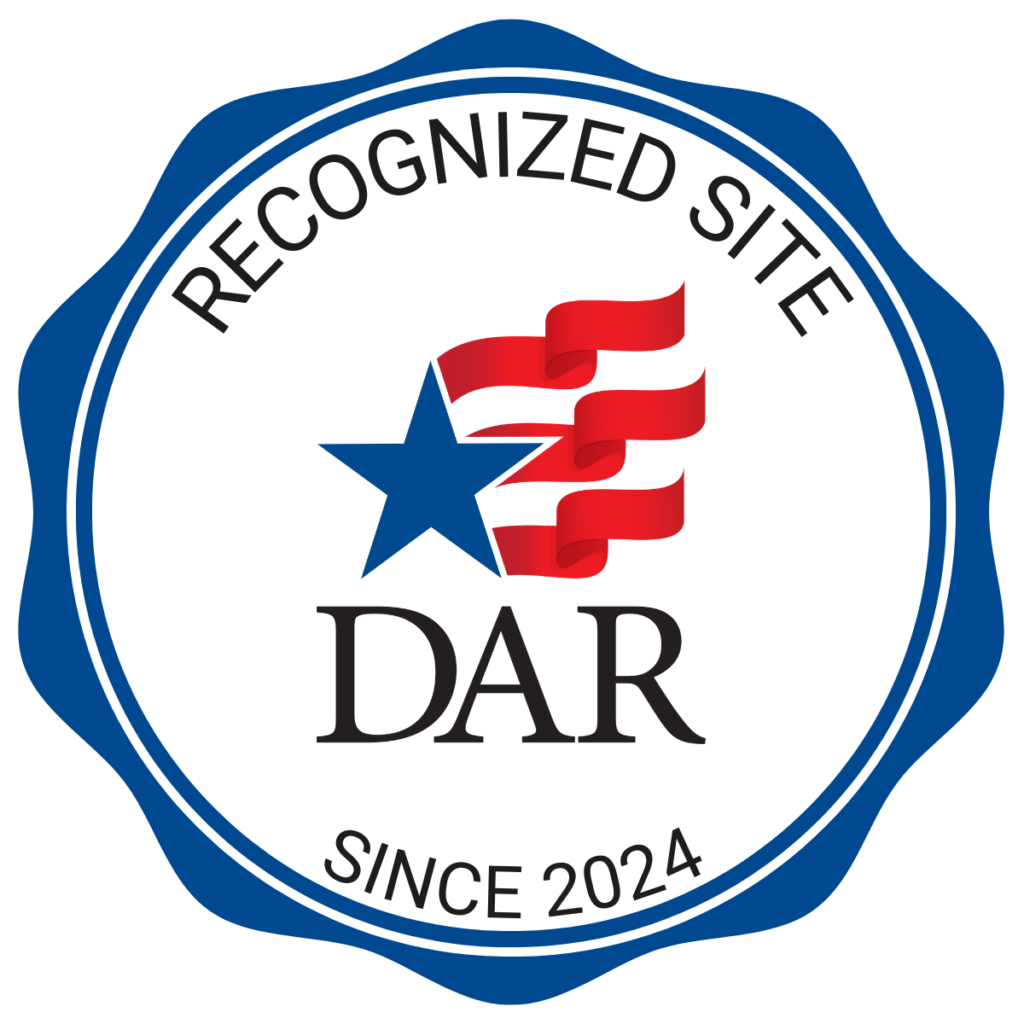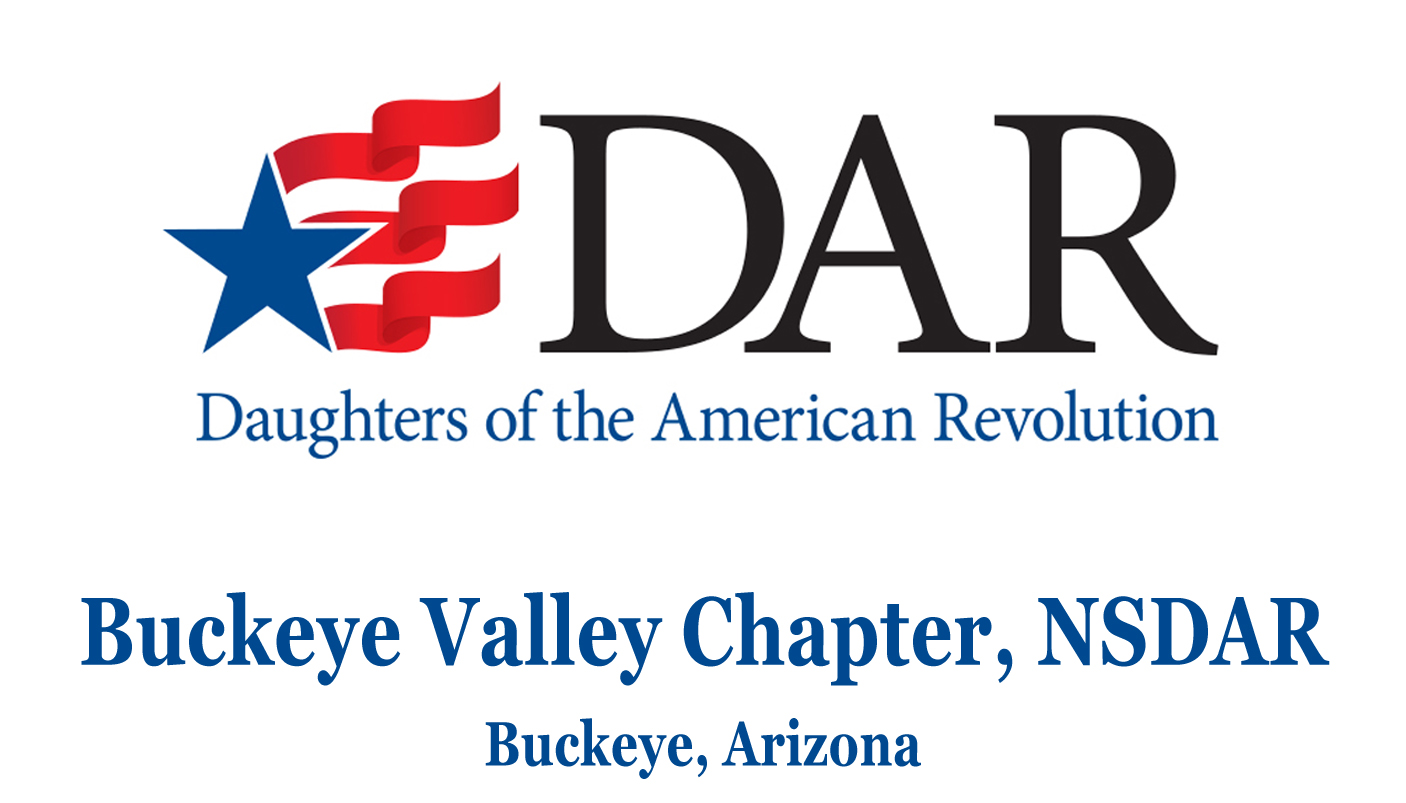Daughters of the American Revolution
The National Society of the Daughters of the American Revolution (NSDAR or DAR) is a service organization open to any woman age 18 years or older who can prove lineal descent from an American Revolutionary War Patriot. Much of the work of DAR is accomplished by volunteers in its chapters across the United States and internationally in order to promote historic preservation, education, and patriotism.
Our Chapter
Buckeye Valley Chapter, NSDAR, is a local chapter of DAR organized on June 11, 2006, with 14 charter members. The chapter serves the Buckeye Valley, including the towns of Liberty, Palo Verde, Tonopah, and Arlington. Chapter meetings are held monthly September through May in the early afternoon. Our officers are:
Regent – Gina Ragsdale
Vice Regent – Kandy Wagenbach
Chaplain – Linda Hardison
Recording Secretary – Laura Blake
Treasurer – Rhonda Johnson
Registrar – Linda Davis
In keeping with the objectives of the National Society, chapter members work together on numerous projects in order to promote historic preservation, education, and patriotism. Learn more about our activities.
We invite you to contact our chapter registrar who will help you get started in becoming a member of DAR, including tracing your heritage to find an American Revolutionary War Patriot.
Buckeye Area History
The record of human sojourn in the Buckeye Valley and southwest Arizona began millennia ago. Scientists believe the first inhabitants in Arizona appeared around 13,000 years ago; these were highly mobile bands of 20 to 50 people who followed big game herds and were known as the Paleo-Indian tradition (10500-7500 BC). After the Younger Dryas Cold Event (big freeze), hunter-gatherer groups appeared, 8,000-2,000 years ago, known as the Southwest Archaic tradition. Out of these groups evolved the rich cultures of the ancient Pueblo, the Mogollon, and the Hohokam. A fourth culture also emerged, the Patayan, who inhabited the southern areas of California, Arizona, and Baja California (700-1550 AD).
In the Phoenix Basin and eastern Buckeye Valley, the Hohokam (200 BC-1450 AD) developed a massive irrigation system that permitted the growing of crops, a ball court system, public architecture, and permanent settlements. Eventually, these cultures, along with migrating tribes from the Great Plains, became today’s tribal nations.
Cabeza de Vaca (c. 1536) and Coronado (1540) were the first European explorers to enter the region and claim much of the Southwest for the Spanish Empire. Jesuit and later Franciscan priests entered the territory from Mexico, residing here from about 1600 to 1780 AD, bringing tools, new cultivars, horses, sheep, and a new religion to the people of southern Arizona. The Arizona region came under Mexican control following the Mexican War of Independence from Spain (1810-1821).
Except for the native inhabitants, the lands of what would someday become Arizona remained vacant. Then around 1820, European emigrants began crossing the territory: explorers, fur trappers, miners, ranchers, and homesteaders. In 1850, Arizona became part of the territory of New Mexico following the end of the War with Mexico in 1848.
In 1885, M. M. Jackson and others located an irrigation ditch at the junction of the Agua Fria and the Gila Rivers. Later, they conveyed their rights to Mose Clanton and others who organized the Buckeye Canal Company. With ample water, homesteaders were able to take root in the Buckeye Valley. The Clanton family arrived in 1887 and established the Buckeye Post Office in 1888. That same year Clanton and O.L. Mahoney subdivided their property to form the town site of Sidney. The town was formally renamed Buckeye in 1910 to coincide with the post office and canal. With the perseverance of the homesteaders, the barren desert transformed into the fertile valley of today.
Many young men and women from the Buckeye Valley have served their country in times of war. Notables include Louis B. Hazelton, the first Buckeye man to lose his life in WWI. In 1938 the cemetery on 23100 W. Broadway Road was established and named in his honor. In 1944, the USS John C. Butler destroyer was launched, named for John C. Butler, a casualty of WWII. A memorial in Benbow Park on Monroe Avenue contains the names of Buckeye area veterans.
The new millennium marked a huge population boom in Buckeye, swelling from 6,500 souls in 2000 to 51,000 in 2010, an increase of 678.3%. The town’s city limits now stand at 145.8 sq. mi. Town property straddles both sides of Interstate 10, connecting Arizona with the Southwest and the entire nation. Today Buckeye is a mixture of old and new communities. Buckeye’s small-town charm is preserved in its historic Old Town Buckeye section along Monroe Avenue. Many generations have called this place “home” and celebrate the spirit of community which is alive and well in the Buckeye Valley.
Notes:
(1) For a more detailed timeline, consult Buckeye: The First 100 Years, 1888-1988 by Edith Mae Sandell Christian (1988).
(2) Area archaeological sites are chronicled at the Buckeye Valley Historical and Archaeological Museum.

Request Membership Information
Website last updated: August 31, 2024
The content contained herein does not necessarily represent the position of the NSDAR.
Hyperlinks to other sites are not the responsibility of the NSDAR, the state organizations
or individual DAR chapters.
